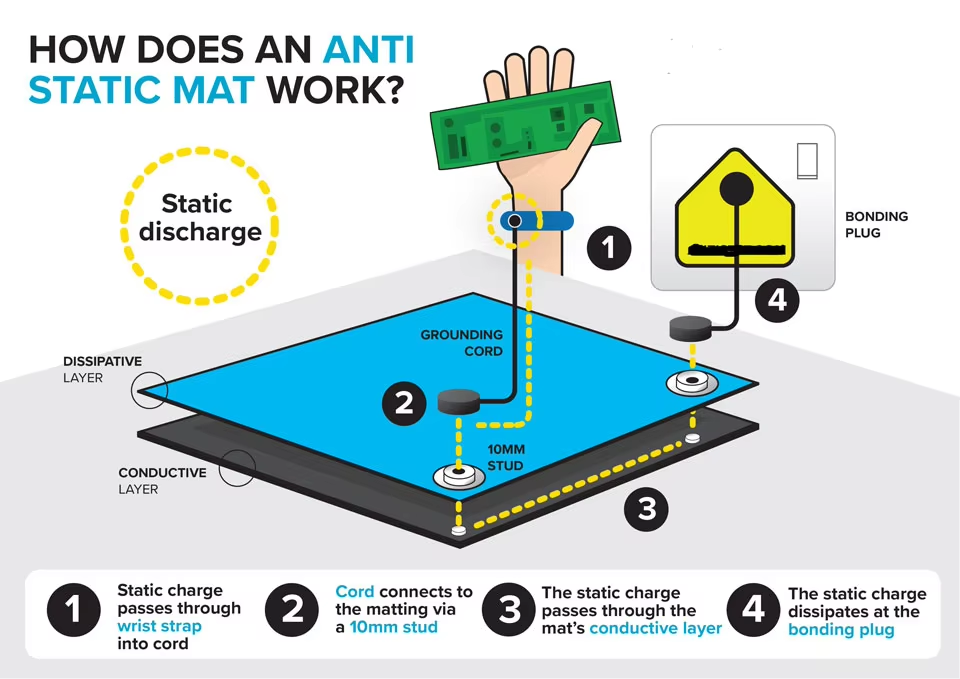Why Is Managing ESD Important?
Upload Time:
Oct 13, 2025
Why Is Managing ESD Important?
Static discharge is destructive to sensitive electronic components. Even 1 volt of electricity is enough to cause damage, but most devices need around 100 volts to cause damage that is beyond repair.
Humans cannot feel a static discharge unless it is 2,000 volts or higher. So, if you don’t feel a zap, it doesn’t mean a static discharge did not happen or damage your electronic components.
Many industries depend on electronic components and their reliability to work in harsh conditions, so the need for reliable ESD-safe equipment is significant.
Electronic component producers are often unaware that static discharge has damaged their products during the assembly process unless they test all components one by one or see their final product fail after assembly. If these products were used in aerospace, one minor problem on a small component could lead to an enormous failure, which is why ESD is a significant challenge for many industries.
Typical Electrostatic Voltages
- Walking across a carpet: 1,500 – 35,000 volts.
- Operator at a bench: 100 – 6,000 volts.
- Walking over an untreated vinyl floor: 250 – 12,000 volts.
- Picking up a standard plastic bag from a bench: 1,200 – 20,000 volts.
- Chair with urethane foam: 1,500 – 18,000 volts.
What Voltage Can Damage Components?
The voltage can be as little as 10 volts depending on the size, sensitivity and type of component. To comply with the British standard, 100V is the maximum threshold that can be produced within an EPA.
Potential Difference
The potential difference causes ESD when there is a difference in charge between two objects. These can include work surfaces, articles of clothing, people, flooring and shelving/conveyors.
ESD Symbols
If you’ve been handling static sensitive devices for a while, you’ve most likely come across the various ESD symbols already. But do you know the difference(s) and when to use them? If you are new to ESD protection or have just taken over responsibility for an existing ESD program, keep reading below!
The ESD Standard ANSI/ESD S20.20 requires that “ESDS items, system or packaging marking shall be in accordance with customer contracts, purchase orders, drawing or other documentation.” [ANSI/ESD S20.20 clause 8.5 Marking] . If ESD sensitive items are not covered in any of these documents, each company has to decide whether marking is required. If it is deemed necessary, the ESD Control Program Plan needs to define the details.
ESD Protective symbol
SHAPE * MERGEFORMAT
Just like the ESD Susceptibility Symbol, the ESD Protective Symbol has a reaching hand in a triangle. However, note the arc and missing slash through the triangle! Because of these differences it has a very different meaning.
This symbol should be on ESD protective products identifying a specialty product that has at least one ESD control property.
The ESD Protective Symbol is also called the ESD Packaging Symbol.
Used to designate all ESD protective products such as bags, boxes, garments. A letter is added under the symbol to indicate the primary function:
- C – conductive (For use in ESD Protected Areas)
- D – dissipative
- S – shielding
- L – low charging
Colour of the ESD Protective Symbol
The color is optional except “the color red shall not be used because it suggests a hazard to personnel.” [ANSI/ESD S8.1 clause 5.2.1 color] .
Normally, a hand symbol is used on a black triangle on a yellow background.
Relevant News







